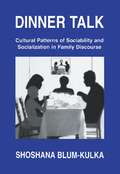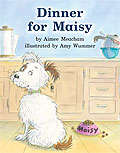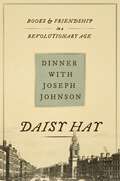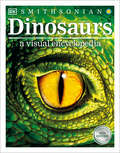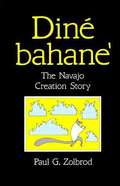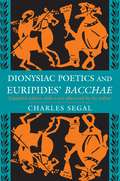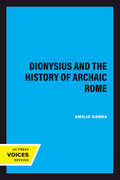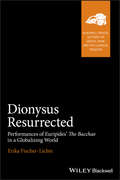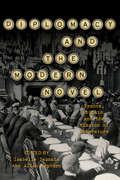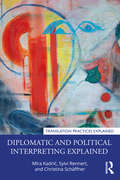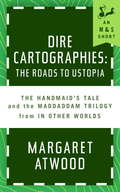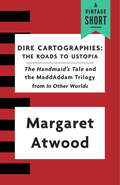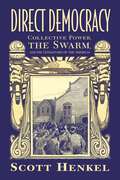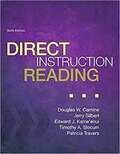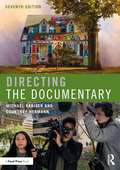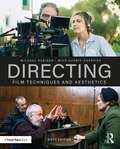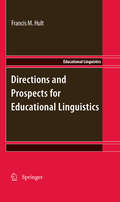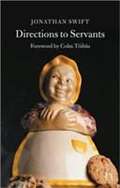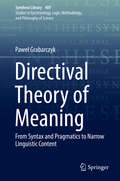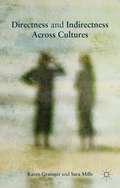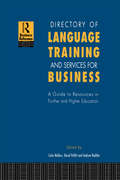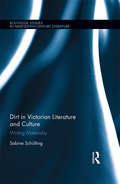- Table View
- List View
Dinner Talk: Cultural Patterns of Sociability and Socialization in Family Discourse
by Shoshana Blum-KulkaDinner Talk draws upon the recorded dinner conversations of, and extensive interviews with, native Israeli, American Israeli, and Jewish American middle-class families to explore the cultural styles of sociability and socialization in family discourse. The thesis developed is that family dinners in Western middle-class homes fulfill important functions of sociability for all participants and, at the same time, serve as crucial sites of socialization for children through language and for language use. The book demonstrates the way talk at dinner constructs, reflects, and invokes familial, social, and cultural identities and provides social support for easing the passage of children into adult discourse worlds. Family discourse at dinner emerges as a particularly rich site for discursive socialization and a highly meaningful enactment of sociable behavior in culturally patterned ways. Although all the families studied have a commom Eastern European background, Israeli and Jewish American families are shown to differ extensively in their interactional styles, in ways that enact historically different, community-related interpretations of the dialectics of continuity and change. Native Israeli, American Israeli, and Jewish American families differ culturally in the ways they negotiate issues of power, independence, and involvement through various speech activities such as the choice and initiation of topics, conversational story-telling, naming practices, metapragmatic discourse, politeness strategies, and in immigrant, bilingual families, language choice and code switching. Dinner Talk demonstrates the unique interactional style of each of the groups, linking the observed communication patterns to the ideological, sociocultural, and historical contexts of their respective communities.This innovative study of family discourse from a cross-cultural perspective will appeal to students and specialists in sociolinguistics, communication, anthropology, child language, and family and Jewish studies, as well as to all interested in patterns of communication within families.
Dinner for Maisy (Fountas & Pinnell LLI Green #Level H, Lesson 85)
by Aimee MeachamFountas and Pinnell Leveled Literacy Intervention Green System -- 1st Grade
Dinner with Joseph Johnson: Books and Friendship in a Revolutionary Age
by Daisy HayA fascinating portrait of a radical age through the writers associated with a London publisher and bookseller—from William Wordsworth and Mary Wollstonecraft to Benjamin FranklinOnce a week, in late eighteenth-century London, writers of contrasting politics and personalities gathered around a dining table. The veal and boiled vegetables may have been unappetising but the company was convivial and the conversation brilliant and unpredictable. The host was Joseph Johnson, publisher and bookseller: a man at the heart of literary life. In this book, Daisy Hay paints a remarkable portrait of a revolutionary age through the connected stories of the men and women who wrote it into being, and whose ideas still influence us today.Johnson’s years as a publisher, 1760 to 1809, witnessed profound political, social, cultural and religious changes—from the American and French revolutions to birth of the Romantic age—and many of his dinner guests and authors were at the center of events. The shifting constellation of extraordinary people at Johnson’s table included William Blake, William Wordsworth, Samuel Taylor Coleridge, Benjamin Franklin, the scientist Joseph Priestly and the Swiss artist Henry Fuseli, as well as a group of extraordinary women—Mary Wollstonecraft, the novelist Maria Edgeworth, and the poet Anna Barbauld. These figures pioneered revolutions in science and medicine, proclaimed the rights of women and children and charted the evolution of Britain’s relationship with America and Europe. As external forces conspired to silence their voices, Johnson made them heard by continuing to publish them, just as his table gave them refuge.A rich work of biography and cultural history, Dinner with Joseph Johnson is an entertaining and enlightening story of a group of people who left an indelible mark on the modern age.
Dinosaurs: A Visual Encyclopedia, 2nd Edition (DK Children's Visual Encyclopedias)
by DKBe brave as you meet the most incredible creatures to ever walk the Earth in this top-selling book.The ultimate visual encyclopedia introduces a huge variety of record-breaking dinosaurs in mind-blowing detail.Dinosaurs: A Visual Encyclopedia charts the entire history of life on our planet, from the very first life forms through the range of prehistoric creatures and the diverse species of the Ice Ages. This curious mixture of the weird and wonderful is shown in stunning expert-verified reconstructed images alongside fascinating fact files and additional information about habitat, diet, and behavior. You might already be able to tell your Tyrannosaurus Rex from Triceratops, but have you ever seen horse-eating birds and millipedes the size of crocodiles? Then look no further.Other topics such as evolution, fossilization, and climate change are explored in-depth to build up a complete picture of the dinosaur era.Dinosaur fans and fossil hunters, what are you waiting for?
Diné Bahane': The Navajo Creation Story
by Paul G. ZolbrodThis is the most complete version of the Navajo creation story to appear in English since Washington Matthews' Navajo Legends of 1847. Zolbrod's new translation renders the power and delicacy of the oral storytelling performance on the page through a poetic idiom appropriate to the Navajo oral tradition. Zolbrod's book offers the general reader a vivid introduction to Navajo culture. For students of literature this book proposes a new way of looking at our literary heritage.
Dionysiac Poetics and Euripides' Bacchae: Expanded Edition
by Charles SegalIn his play Bacchae, Euripides chooses as his central figure the god who crosses the boundaries among god, man, and beast, between reality and imagination, and between art and madness. In so doing, he explores what in tragedy is able to reach beyond the social, ritual, and historical context from which tragedy itself rises. Charles Segal's reading of Euripides' Bacchae builds gradually from concrete details of cult, setting, and imagery to the work's implications for the nature of myth, language, and theater. This volume presents the argument that the Dionysiac poetics of the play characterize a world view and an art form that can admit logical contradictions and hold them in suspension.
Dionysius and The History of Archaic Rome (Sather Classical Lectures #56)
by Emilio GabbaIn The History of Archaic Rome, Dionysius purposely viewed Roman history as an embodiment of all that was best in Greek culture. Gabba places Dionysius's remarkable thesis in its cultural context, comparing this author with other ancient historians and evaluating Dionysius's treatment of his sources.In truth, the last decades B.C. made the historian's task an enormous challenge. On the one hand, the ancient writers knew Rome to be the greatest empire the world had seen, seemingly impregnable in military power and still capable of expansion. On the other hand, they were acutely aware that it recently had barely survived half a century of civil strife.Gabba recalls to us how little was confidently known of Rome's actual origins in an illuminating examination of Dionysius's methodology as a historian.
Dionysus Resurrected: Performances of Euripides' The Bacchae in a Globalizing World (Blackwell-Bristol Lectures on Greece, Rome and the Classical Tradition)
by Erika Fischer-LichteDionysus Resurrected analyzes the global resurgence since the late 1960s of Euripides’ The Bacchae. By analyzing and contextualizing these modern day performances, the author reveals striking parallels between transformational events taking place during the era of the play’s revival and events within the play itself. Puts forward a lively discussion of the parallels between transformational eventsduring the era of the play’s revival and events within the play itself The first comparative study to analyse and contextualize performances of The Bacchae that took place between 1968 and 2009 from the United States, Africa, Latin America, Europe and Asia Argues that presentations of the play not only represent liminal states but also transfer the spectators into such states Contends that the play’s reflection on various stages of globalization render the tragedy a contemporary play Establishes the importance of The Bacchae within Euripides’ work as the only extant tragedy in which the god Dionysus himself appears, not just as a character but as the protagonist
Diplomacy and the Modern Novel: France, Britain, and the Mission of Literature
by Isabelle Daunais and Allan HepburnBetween 1900 and 1960, many writers in France and Britain either had parallel careers in diplomatic corps or frequented diplomatic circles: Paul Claudel, Albert Cohen, Lawrence Durrell, Graham Greene, John le Carré, André Malraux, Nancy Mitford, Marcel Proust, and others. What attracts writers to diplomacy, and what attracts diplomats to publishing their experiences in memoirs or novels? Like novelists, diplomats are in the habit of describing situations with an eye for atmosphere, personalities, and looming crises. Yet novels about diplomats, far from putting a solemn face on everything, often devolve into comedy if not outright farce. Anachronistic yet charming, diplomats take the long view of history and social transformation, which puts them out of step with their times – at least in fiction. In this collection of essays, eleven contributors reflect on diplomacy in French and British novels, with particular focus on temporality, style, comedy, characterization, and the professional liabilities attached to representing a state abroad. With archival examples as evidence, the essays in this volume indicate that modern fiction, especially fiction about diplomacy, is a response to the increasing speed of communication, the decline of imperial power, and the ceding of old ways of negotiating to new.
Diplomatic and Political Interpreting Explained (Translation Practices Explained)
by Mira Kadrić Sylvi Rennert Christina SchäffnerThe role of the interpreter at international meetings of politicians and diplomats is a critical one. This book examines the history of diplomacy and diplomatic interpreting as well as the rules and realities of modern diplomatic relations. Building on interviews with interpreters, diplomats and politicians, it examines language as a tool of diplomatic and political communication, the role of interpreters in diplomacy, and the different forms of interaction and communicative behaviour interpreters face and exhibit. The book covers the different ways in which interpreters manage information, expressivity, and interaction, and what diplomats think about it. Each chapter presents key concepts and definitions; examples from existing literature are combined with interviews conducted with professional interpreters as well as seasoned diplomats and politicians to illustrate their relevance in interpreting practice. With activities for group work and self-study, including analysis and discussion of real-life interpreted diplomatic or political events, this book offers a range of interpreting exercises that encourage students to apply the different strategies discussed in the book. Weaving together the voices of interpreters, diplomats, and politicians with a systematic look at the theory and practice of interpreting in diplomatic settings, this is not only an essential textbook for interpreting students and educators but will also be of interest to professional interpreters and students and scholars of politics and international relations. Additional resources are available on the Routledge Translation Studies Portal: http://routledgetranslationstudiesportal.com
Dire Cartographies
by Margaret AtwoodIn honor of the thirtieth anniversary of The Handmaid's Tale: Margaret Atwood describes how she came to write her utopian, dystopian works. The word "utopia" comes from Thomas More's book of the same name--meaning "no place" or "good place,"" or both. In "Dire Cartographies," from the essay collection In Other Worlds, Atwood coins the term "ustopia,"" which combines utopia and dystopia, the imagined perfect society and its opposite. Each contains latent versions of the other. Following her intellectual journey and growing familiarity with ustopias fictional and real, from Atlantis to Avatar and Beowulf to Berlin in 1984 (and 1984), Atwood explains how years after abandoning a PhD thesis with chapters on good and bad societies, she produced novel-length dystopias and ustopias of her own. "My rules for The Handmaid's Tale were simple," Atwood writes. "I would not put into this book anything that humankind had not already done, somewhere, sometime, or for which it did not already have the tools." With great wit and erudition, Atwood reveals the history behind her beloved creations.
Dire Cartographies: The Roads to Ustopia and The Handmaid's Tale (A Vintage Short)
by Margaret AtwoodIn honor of the thirtieth anniversary of The Handmaid's Tale: Margaret Atwood describes how she came to write her utopian, dystopian works. The word "utopia" comes from Thomas More's book of the same name--meaning "no place" or "good place," or both. In "Dire Cartographies," from the essay collection In Other Worlds, Atwood coins the term "ustopia," which combines utopia and dystopia, the imagined perfect society and its opposite. Each contains latent versions of the other. Following her intellectual journey and growing familiarity with ustopias fictional and real, from Atlantis to Avatar and Beowulf to Berlin in 1984 (and 1984), Atwood explains how years after abandoning a PhD thesis with chapters on good and bad societies, she produced novel-length dystopias and ustopias of her own. "My rules for The Handmaid's Tale were simple," Atwood writes. "I would not put into this book anything that humankind had not already done, somewhere, sometime, or for which it did not already have the tools." With great wit and erudition, Atwood reveals the history behind her beloved creations.
Dire Straits
by Elizabeth Jane BellamyEngland became a centrally important maritime power in the early modern period, and its writers - acutely aware of their inhabiting an island - often depicted the coastline as a major topic of their works. However, early modern English versifiers had to reconcile this reality with the classical tradition, in which the British Isles were seen as culturally remote compared to the centrally important Mediterranean of antiquity. This was a struggle for writers not only because they used the classical tradition to legitimate their authority, but also because this image dominated cognitive maps of the oceanic world.As the first study of coastlines and early modern English literature, Dire Straits investigates the tensions of the classical tradition's isolation of the British Isles from the domain of poetry. By illustrating how early modern English writers created their works in the context of a longstanding cultural inheritance from antiquity, Elizabeth Jane Bellamy offers a new approach to the history of early modern cartography and its influences on literature.
Direct Democracy: Collective Power, the Swarm, and the Literatures of the Americas (Caribbean Studies Series)
by Scott HenkelWinner of a 2018 C. L. R. James Award for a Published Book for Academic or General Audiences from the Working-Class Studies Association Beginning with the Haitian Revolution, Scott Henkel lays out a literary history of direct democracy in the Americas. Much research considers direct democracy as a form of organization fit for worker cooperatives or political movements. Henkel reinterprets it as a type of collective power, based on the massive slave revolt in Haiti. In the representations of slaves, women, and workers, Henkel traces a history of power through the literatures of the Americas during the long nineteenth century.Thinking about democracy as a type of power presents a challenge to common, often bureaucratic and limited interpretations of the term and opens an alternative archive, which Henkel argues includes C. L. R. James's The Black Jacobins, Walt Whitman's Democratic Vistas, Lucy Parsons's speeches advocating for the eight-hour workday, B. Traven's novels of the Mexican Revolution, and Marie Vieux Chauvet's novella about Haitian dictatorship.Henkel asserts that each writer recognized this power and represented its physical manifestation as a swarm. This metaphor bears a complicated history, often describing a group, a movement, or a community. Indeed it conveys multiplicity and complexity, a collective power. This metaphor's many uses illustrate Henkel's main concerns, the problems of democracy, slavery, and labor, the dynamics of racial repression and resistance, and the issues of power which run throughout the Americas.
Direct Instruction Reading
by Douglas W. Carnine Edward J. Kame'Enui Timothy A. Slocum Patricia A. TraversNote: This is the loose-leaf version of Direct Instruction Reading and does not include access to the Enhanced Pearson eText. To order the Enhanced Pearson eText packaged with the loose-leaf version, use ISBN 0133827089. Novice and expert teachers alike get the detailed guidance they need to be successful teaching any child who struggles with reading in the alphabetic writing system. Unique in its approach of leaving little to chance or guesswork, Direct Instruction Reading details how to teach, what to teach, why it is important to teach it, when to teach it, how long, how often, at what starting point in time, and to what criterion level of performance. For example, teaching format specify a) example words to teach; b) explicit directions for modeling how to read the words; c) explicit directions for how to guide students in their responses to teaching to teacher prompts; and d) explicit wording for correcting student errors. The book is designed to give both novice teachers with limited or no teaching experience, as well as the expert teacher with extensive teaching experience the detailed guidance they need to be successful teaching any child who struggles with reading in the alphabetic writing system. This new edition features chapter Learning Outcomes; a new chapter on Response to Intervention (RtI); information relating the Common Core State Standards (CCSS) to the Direct Instruction approach; web resources, video links, and other general research reference sources; explicit references and links to the most rigorous research available through the Institute of Education Sciences (IES); and updated research throughout. The Enhanced Pearson eText features embedded video.
Directing the Documentary
by Michael Rabiger Courtney HermannDirecting the Documentary is the definitive book on the documentary form, that will allow you to master the craft of documentary filmmaking. Focusing on the hands-on work needed to make your concept a reality, it covers the documentary filmmaking process from top to bottom, providing in-depth lessons on every aspect of preproduction, production, and postproduction. The book includes dozens of projects, practical exercises, and thought-provoking questions, and offers best practices for researching and honing your documentary idea, developing a crew, guiding your team, and much more. This fully revised and updated 7th edition also includes brand new content on the rise of the documentary series, the impact of video on-demand and content aggregators, updated information on prosumer and professional video (including 4K+), coverage of new audio & lighting solutions and trends in post-production, coverage of the immersive documentary, and provides practical sets of solutions for low, medium, and high budget documentary film productions throughout. The companion website has also been fully updated to a variety of new projects and forms. By combining expert advice on the storytelling process, the technical aspects of filmmaking and commentary on the philosophical underpinnings of the art, this book provides the practical and holistic understanding you need to become a highly regarded, original, and ethical contributor to the genre. Ideal for both aspiring and established documentary filmmakers, this book has it all.
Directing: Film Techniques and Aesthetics
by Michael Rabiger Mick Hurbis-CherrierDirecting: Film Techniques and Aesthetics is a comprehensive exploration into the art and craft of directing for film and television. It’s filled with practical advice, essential technical information, and inspiring case studies for every stage of production. This book covers the methods, technologies, thought processes, and judgments that a director must use throughout the fascinating process of making a film, and concentrates on developing the human aspects of cinema to connect with audiences.The fully revised and updated 6th edition features new sections on using improvisation, the development of characters for long form television series, visual design, the role of the digital imaging technician, film promotion and distribution, alongside expanded information on contemporary color grading tools, stylistic approaches and genre, workflows, blocking scenes for the camera and more. The book emphasizes independent and short form cinema which allows cutting-edge creativity and professionalism on shoestring budgets. Recognizing that you learn best by doing, it includes dozens of practical hands-on projects and activities to help you master technical and conceptual skills. Just as important as surmounting technological hurdles is the conceptual and authorial side of filmmaking. This book provides an unusually clear view of the artistic process, particularly in working with actors and principle crew members. It offers eminently practical tools and exercises to help you develop your artistic identity, find credible and compelling stories, choose and work with your cast and hone your narrative skills. Directing shows you how to surpass mere technical proficiency and become a storyteller with a distinctive voice and style. The accompanying companion website includes film analysis exercises, shooting projects, checklists and assignment forms, analytical questionnaires, updated production forms and logs for all phases of a project with links to additional resources and set safety advice.
Directions Home
by George Elliott ClarkeThe latest work from pioneering scholar George Elliott Clarke, Directions Home is the most comprehensive analysis of African-Canadian texts and writers to date. Building on the discoveries of his critically acclaimed Odysseys Home, Clarke passionately analyses the beautiful complexities and haunting conundrums of this important body of literature.Directions Home explores the trajectories and tendencies of African-Canadian literature within the Canadian canon and the socio-cultural traditions of the African Diaspora. Clarke showcases the importance of little-known texts, including church histories and slave narratives, and offers studies of autobiography, crime and punishment, jazz poetics, and musical composition. The collection also includes studies of significant contemporary writers such as George Boyd and Dionne Brand, and trailblazing African-Canadian intellectuals like A.B. Walker and Anna Minerva Henderson. With its national, bilingual, and historical perspectives, Directions Home is an essential guide to African-Canadian literature.
Directions and Prospects for Educational Linguistics
by Francis M. HultDirections and Prospects for Educational Linguistics explores innovations that have developed from the creative syntheses of diverse methodological and theoretical approaches used to explore a broad rang of issues and topics related to language (in) education. The volume provides unique insights into current practices and new frontiers for educational linguistics by bringing together contributions from scholars who draw upon on established research traditions while at the same time pushing their boundaries beyond the confines of specific disciplines. Each paper serves as a thought provoking starting point for scholars and advanced graduate students to contemplate directions and prospects for research that contributes to linguistically appropriate and socially responsible education.
Directions to Servants
by Jonathan SwiftDirections to Servants is one of Jonathan Swift's last completed works. It displays all his caustic skill as a satirist and his unerring eye for the little annoyances of life.
Directival Theory of Meaning: From Syntax and Pragmatics to Narrow Linguistic Content (Synthese Library #409)
by Paweł GrabarczykThis book presents a new approach to semantics based on Kazimierz Ajdukiewicz’s Directival Theory of Meaning (DTM), which in effect reduces semantics of the analysed language to the combination of its syntax and pragmatics. The author argues that the DTM was forgotten because for many years philosophers didn’t have conceptual tools to appreciate its innovative nature, and that the theory was far ahead of its time.The book shows how a redesigned and modernised version of the DTM can deliver a new solution to the problem of defining linguistic meaning and that the theory can be understood as a new type of functional role semantics. The defining feature of the DTM is that it presents meaning as a product of constraints on the usage of words. According to the DTM meaning is not use, but the avoidance of misuse.Readers will see how the DTM was shelved for reasons that we don’t find so dramatic anymore, and how it contains enough original ideas and solutions to warrant developing it into a full-blown contemporary account. It is shown how many of the underlying ideas of the theory have been embraced later by philosophers and treated simply as brute facts about natural languages or even as new philosophical discoveries.Philosophers of language and researchers with an interest in how languages and the mind work will find this book a fascinating read.
Directness and Indirectness Across Cultures
by Sara Mills Karen GraingerThis book analyses the complex relationship between directness, indirectness, politeness and impoliteness. Definitions of directness and indirectness are discussed and problematised from a discursive theoretical perspective.
Directness and Indirectness Across Cultures
by Sara Mills Karen GraingerThis book analyses the complex relationship between directness, indirectness, politeness and impoliteness. Definitions of directness and indirectness are discussed and problematised from a discursive theoretical perspective.
Directory of Language Training and Services for Business: A Guide to Resources in Further and Higher Education
by Colin Mellors David Pollitt Andrew RadtkeLanguage acquisition and training is a key concern for businesses of all types and sizes. This Directory is an invaluable resource for anyone needing information on language training for business. The Directory also provides information on services for business such as translation and interpreting. Ordered A-Z by institution, the Directory will enable speedy identification of providers from a bank of over 400 institutional and other contacts across the UK.
Dirt in Victorian Literature and Culture: Writing Materiality (Routledge Studies in Nineteenth Century Literature)
by Sabine SchültingAddressing the Victorian obsession with the sordid materiality of modern life, this book studies dirt in nineteenth-century English literature and the Victorian cultural imagination. Dirt litters Victorian writing – industrial novels, literature about the city, slum fiction, bluebooks, and the reports of sanitary reformers. It seems to be "matter out of place," challenging traditional concepts of art and disregarding the concern with hygiene, deodorization, and purification at the center of the "civilizing process." Drawing upon Material Cultural Studies for an analysis of the complex relationships between dirt and textuality, the study adds a new perspective to scholarship on both the Victorian sanitation movement and Victorian fiction. The chapters focus on Victorian commodity culture as a backdrop to narratives about refuse and rubbish; on the impact of waste and ordure on life stories; on the production and circulation of affective responses to filth in realist novels and slum travelogues; and on the function of dirt for both colonial discourse and its deconstruction in postcolonial writing. They address questions as to how texts about dirt create the effect of materiality, how dirt constructs or deconstructs meaning, and how the project of writing dirt attempts to contain its excessive materiality. Schülting discusses representations of dirt in a variety of texts by Charles Dickens, E. M. Forster, Elizabeth Gaskell, George Gissing, James Greenwood, Henry James, Charles Kingsley, Henry Mayhew, George Moore, Arthur Morrison, and others. In addition, she offers a sustained analysis of the impact of dirt on writing strategies and genre conventions, and pays particular attention to those moments when dirt is recycled and becomes the source of literary creation.
